A relatively prominent but minor constellation in the southern sky below Virgo. Its brightest star, Spica, is pointed at by the two stars of the Raven's Wing. The constellation's four main stars (γ, δ, β, ε Corvo) range in magnitude from 2.5 to 3 and form a striking trapezoid. This pattern is particularly striking because it lies in a relatively star-poor region - 10 degrees southwest of Spica. The Raven is not a very interesting constellation, but it does contain several attractive binaries and a couple of fairly bright galaxies. The most prominent of these is NGC 4038-39, a pair of interacting galaxies called the Antennae.
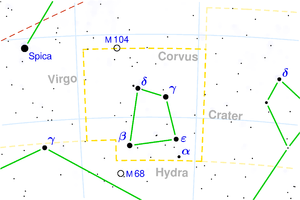
Algorab (δ Crv) - With a telescope with an objective diameter of at least 8 cm, we will see at a distance of 24.2" from the bright white component of third magnitude a faint pale blue companion of 9th stellar magnitude. This system is located 88 light years away from us.
R Corvi - The orange-red variable star of Mira type changes its brightness in the range of magnitude 6.7 to 14.4 in a period of 10 months - 317 days. It forms the western vertex of a triangle together with two stars of magnitude 7.5. During their maximum, it brightly illuminates them, while during its minimum, it can hardly be seen even in a larger telescope.
NGC 4038
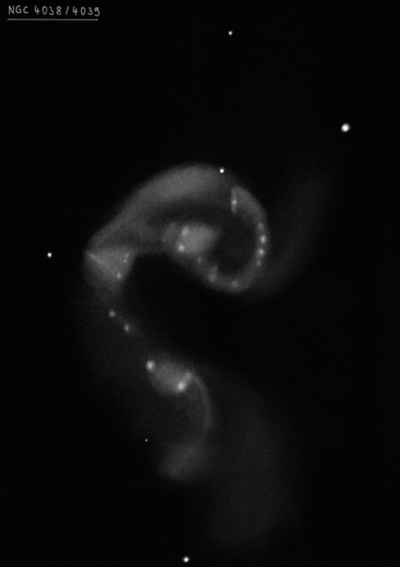
William Herschel discovered NGC 4038 = H IV-28.1 = h1052 on 7 Feb 1785 (sweep 368) and recorded "pB, L. Two joined together [with NGC 4039], the smallest south; or one opening with a branch very faintly joined." WH gave a single entry in class IV (planetary), though John Herschel separated these into IV 28.1 and IV 28.2 in the Slough catalogue. Bindon Stoney sketched the galaxy pair on 14 Apr 1852 (included in LdR's 1861 publication). It appears to show one of the long tidal tails.
The long "Antennae" tidal tails were first photographed by Carl Lampland with the 40-inch Lowell reflector in 1917. J.C. Duncan remarked "Most remarkable of all, two faint extensions, like antennae" in the 1923 "Photographic studies of nebulae.III." The Toomre's adopted the nickname "the Antennae" in their early 1972 computer simulation "Galactic Bridges and Tails".
300/350mm - 13" (5/21/82): appears as two irregular galaxies connected at the east end.
400/500mm - 17.5" (5/14/88): fairly bright, moderately large. Forms a striking "shrimp-like" or "comma" shape with the tail attached at the east end and extending to the south. Appears clearly darker between the two objects on the west side.
600/800mm - 24" (4/10/08 - Magellan Observatory, Australia): this was an amazing object in the 24" at 350x. The main, bright northern component (NGC 4038) was partially annular, with a very bright knotty rim and a darker center giving a truly unique appearance for a galaxy. At least 3 knots were visible embedded along its rim. On the SE side is the brightest knot (the nucleus of the galaxy) which appeared faint, small, ~12" diameter. A second fainter knot is on the west side and was only ~6" in size. Finally, a third very faint 6" knot is on the north side. The three knots were roughly spaced out 120° apart along the outer portion of this tortured galaxy. An elongated "arm" (the interacting companion NGC 4039) is attached on the east end and curves around on the south side towards the southwest. Another very faint, but slightly larger 20" knot is embedded along the main portion of NGC 4039, roughly halfway along its length. At the southwest tip of the brighter portion of NGC 4039 was a relatively large, brighter knot (its nucleus) that at times appeared double. Surrounding the southwest portion of NGC 4039 is a much fainter outer halo extended SW-NE. This fainter halo extends further southwest for a few arc minutes and widens to a bulbous shape at the end. This was by far the most detailed view I've seen of the Antennae galaxy. NGC 4027, another disturbed galaxy, lies SW.
900/1200mm - 48" (4/1/11 and 5/3/19): I took a quick look at the Antennae Galaxy on 4/1/11 to see the faint tidal tails that shoot north and south from the east end of NGC 4038/4039. The tidal tail heading south from NGC 4038 (the northern component) was easily visible, sweeping 2' S but then quickly dimming. The streamer heading north was also visible but appeared detached from the galaxies. It was picked up ~2.5' NE of NGC 4038 and extended 2' N, terminating at a faint star.
On 5/3/19 we examined the galaxy using a NPB filter at 375x. Overall the galaxy dimmed but a ring of HII knots extending 270° seemed to light up, providing a striking appearance! They appeared to brighten and dim as individual knots "turned on" with averted vision and gave the impression of viewing car headlights through different layers of fog.
Notes by Steve Gottlieb
NGC 4361
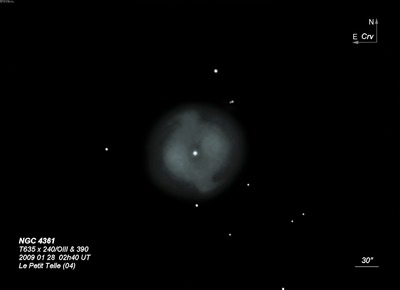
William Herschel discovered NGC 4361 = H I-65 = h1231 on 7 Feb 1785 (sweep 368) and recorded "vB, pL, mbM. The central brightness not round but as if it had two nucleuses pretty closely joined; the chevelure [halo] iR." John Herschel wrote, "vB, L, R, vsmbM to nucl = *11, 90" diameter. R[esolved] with power 320, and is no doubt a globular cluster; fades away to nothing. So, JH was convinced it was a globular. Surprisingly it was misclassified as a galaxy in de Vaucoleurs' 1st "Reference Catalogue of Bright Galaxies" (RC1)!
Based on Crossley photographs at Lick, Curtis described NGC 4361 as "central star about mag 10; this is surrounded by an irregular oval mass whose brighter parts are about 44"x39" in pa 103°. From this central portion two arms (spiral whorls?) go out in pa 20° and portions of a very faint ring 81" can just be made out." (1918PLicO..13...55C). Early photographs were taken with the 30-inch Reynolds reflector between 1912-14 at the Helwan Observatory near Cairo. The director Harold Knox-Shaw also described a "Round nebula 1' diameter from which proceed spiral arms."
300/350mm - 13" moderately bright, fairly large, slightly elongated. The mag 13 central star is fairly easy at 165x.
400/500mm - 17.5" (5/15/99): 100x easily reveals the bright central star surrounded by a moderately high surface brightness halo ~1' in size. At 220x, the central star appears 13th magnitude and the halo gradually brightens towards the center. With averted vision, the halo increases to roughly 90"x60", extended SW-NE, with an ill-defined edge. I had the strong impression of an extension or hook on the southwest end of the PN, which was confirmed on the DSS image (a similar extension is also on the NE end).
900/1200mm - 48" (5/3/19): at 488x; fascinating bright blue planetary with a very bright mag 13 central star. Unfiltered, the unusual feature are two opposite "handles" or thick arcs that are attached just outside the central region on the WNW and ESE sides. Adding a NPB filter, two arms or loops lit up on the SW and NE sides. These loops appeared similar to spiral arms attached to the main body and rotated counterclockwise!
48" (2/20/12): the unusual structure in this planetary shocked me at 488x as previous views in my 17.5" and 18" had only showed a hint of detail. The two main components are large bulbous lobes or wings with an irregular surface brightness that jut out of the central region in a WNW and ESE direction, with the WNW lobe slightly brighter. More surprising were two arms and loops, similar to spiral arms in a galaxy, that extend out to the NE and SW and curve clockwise. The arm to the southwest is very thin where it emerges from the central portion, so it appeared partially detached! The arm on the NE side clearly bends south but was not as sharply defined. Between the lobes (WNW and ESE) and arms (SW and NE) were darker gaps or regions creating a unique, basically symmetric shape that is elongated SW-NE (arms are longer), ~1.8'x1.4'. At the center is a very bright mag 13 central star. A fainter, more roundish halo envelops the brighter components.
Notes by Steve Gottlieb
NGC 4027
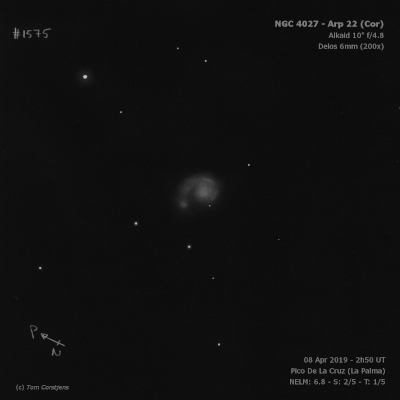
William Herschel discovered NGC 4027 = H II-296 = h3371 on 7 Feb 1785 (sweep 386) and logged "pB, pL." His RA was 1.0 minute of time too large. John Herschel made an interesting description from the Cape of Good Hope: "Globular; F; pL; R; 2'; resolved; stars barely seen; but in a better night for definition would no doubt be clearly resolved into st 16m." His position is accurate, though of course his description isn't valid. It was described as a single branched spiral with condensations in the Helwan Observatory bulletin for 1921, based on photos taken by Knox-Shaw in 1914-16 with the 30" reflector.
200/250mm - 8" (3/28/81): faint, moderately large, no details.
300/350mm - 13.1" (2/16/85): fairly bright, round, moderately large, broad concentration, possible stellar nucleus. A mag 14 star is off the ENE edge 1.0' from center. NGC 4027 is an unusual interacting one-armed barred spiral.
13.1" (9/22/84): a spiral arm is suspected north of the nucleus trailing to the east.
600/800mm - 24" (4/10/08 - Magellan Observatory, Australia): at 260x this is a strange looking one-armed spiral. Overall it appeared quite bright and large with a very irregular shape, 3'x2', and sharply concentrated with a fairly small, round core. The core gradually increased to the center. Emerging from the core on the NW end is a fairly well-defined arm that initially extends north in the direction of a mag 11.8 star located 3.7' NNW of the center of the galaxy. This arm then sharply curves counter-clockwise ~135°, bending around to the N and NE, ending just outside a mag 14 star situated close NE of the core. On the SE end of the core, a second arm begins to emerge but it suddenly terminates, creating a very asymmetric appearance with one long, wrapping arm.
A faint companion, NGC 4027A, lies 4' S. At 260x, this galaxy appeared faint, fairly small, slightly elongated ~N-S, 25"x20", low even surface brightness. A very faint star is attached at the south end. The Antennae galaxy, NGC 4038/4039, lies 40' NE.
900/1200mm - 48" (2/28/19): at 488x; the spectacular spiral arm on the north side of the galaxy wrapped around over 180° and faded out beyond a 14th mag star, nearly due east of the core of the galaxy. The core of the galaxy was roundish but contained a brighter bar oriented E-W. There was a darker region just south of the core, due to dust. NGC 4027A, situated 4' S, appeared fairly faint, moderately large, elongated N-S, irregular, fairly low even surface brightness. An extremely faint star is at the southeast edge.
Notes by Steve Gottlieb
NGC 4782

William Herschel discovered NGC 4782 = H I-135, along with NGC 4783, on 27 Mar 1786 (sweep 548) and recorded "Two, both cB, R, cS, mbM in the direction of the meridian., nearly within 1' of each other, and the chevelure [halo] mixisng." His position is accurate (landing on the southern galaxy). See Harold Corwin's NGC notes on problems with the identifications of the two components.
200/250mm - 8" (3/28/81): faint, very small. Contact pair with NGC 4783 oriented SSW-NNE.
400/500mm - 17.5" (3/23/85): moderately bright, very small, round. Forms an extremely close contact pair with NGC 4783 in a common halo 0.6' NNE of center.
900/1200mm - 48" (4/21/17): at 813x; bright, moderately large, slightly elongated, ~45" diameter, well concentrated with a small bright core. Forms a striking N-S contact pair (halos form a dumbbell or dogbone outline) with NGC 4783 [40" between centers]. A mag 14.5 star is 30" NW, barely outside the halo. A 16th magnitude star is within the northeast side of the halo. NGC 4782/83 are the brightest in a large group that includes NGC 4794 9' ESE and NGC 4792 8' NE.
Notes by Steve Gottlieb
NGC 4724
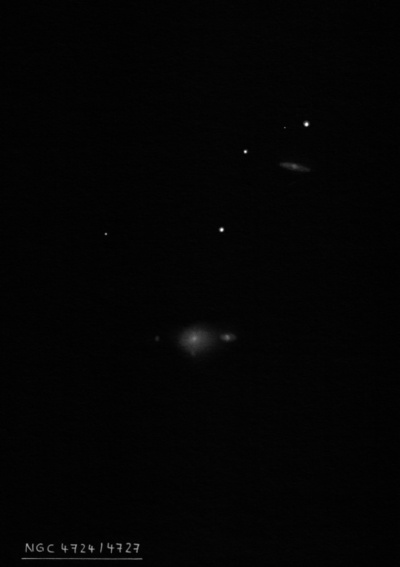
William Herschel discovered NGC 4724 = H III-280 = h1449 on 8 Feb 1785 (sweep 372) and recorded "About half a minute preceding [NGC 4727] is a vS star which I strongly suspect to be stellar, but could not verify it with 240." His position is on[NGC 4727. John Herschel made the single observation "F; R: the np of two, 1' distant."
400/500mm - 18" (5/16/09): faint, very small, round, faint stellar nucleus (or a star is superimposed). Forms a contact pair off the west side of brighter NGC 4727 (50" between center). Two mag 12 stars in an obtuse, isosceles triangle to the north are collinear with the pair.
18" (4/9/05): faint, very small, round, 20" diameter. Contains a faint, quasi-stellar nucleus. Located just off the west side of larger and brighter NGC 4727!
Notes by Steve Gottlieb